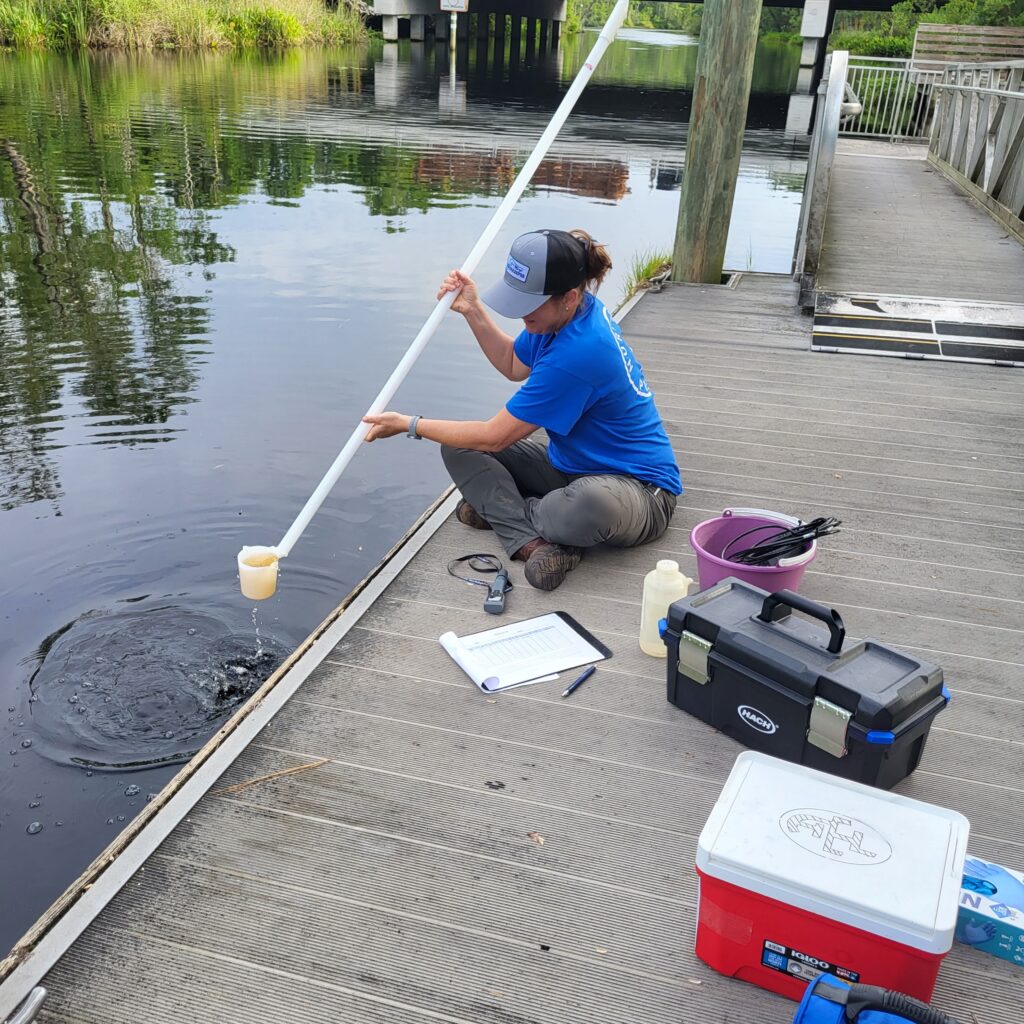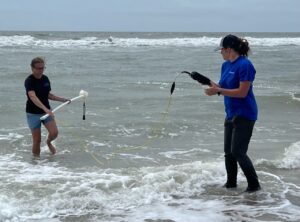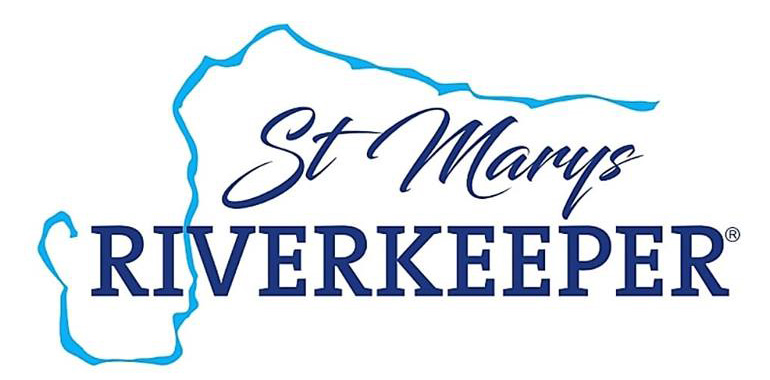Monitoring our river's health to protect our community's health!
All summer long, St. Marys Riverkeeper will be doing additional water sampling in coastal Camden and Nassau Counties for Fecal Indicator Bacteria (FIB), specifically E. coli and Enterococci species, to get a better understanding of the health of our waterways. Warmer waters not only mean more people recreating on the water, but it also results in exponential bacterial growth. This increases people’s chances of getting sick when they come into contact (swimming, recreating, or fishing) with a contaminated waterbody.
Our goals are to ensure our watershed community has a holistic understanding of the health of their waterways and provide necessary information for people to make appropriate decisions on how they choose to recreate on the water.
Why Enterococci and E. coli?

Fecal Coliform is naturally found in the intestines of warm-blooded animals and the presence of this bacteria may indicate contamination of a waterbody by human and/or animal fecal material. Human sources of bacteria include improperly functioning wastewater treatment plants, leaking septic systems, storm water runoff, and runoff from animal manure and manure storage areas.
Enterococci has the ability to survive in saltwater and therefore are the chosen indicator organism for coastal (saline) waterbodies whereas E. coli is only used in fresh water. Our team of dedicated and trained Citizen Scientists will continue their normal water sampling routine throughout the watershed until it is determined whether or not this new protocol is applicable for their sampling sites.
We need your help!
Your support and engagement are critical to our water quality program success!
- Be a Watchdog! Let us know if you have concerns of a possible contaminated waterbody. Things to consider when reporting a waterbody:
- Is the water salty? Sample sites of priority during this campaign are brackish and saltwater systems.
- Do you see a strange film on the surface of the water or does the water have a funny smell? Observing the water is a great indicator of a contamination.
- Are there a lot of older homes on septic along the water’s edge? Septic tanks should be pumped out every 3-5 years and replaced every 20-30 years.
- How accessible is the waterbody? Sampling sites should be easily accessible, safe to be at, and can be visited more than once.
- Should water be flowing or stagnant? The waterbody must have flowing water at the time of sampling. Bacteria can be buried in the sediment and if the soil is disturbed, buried bacteria can be resuspended giving an inaccurate reading.
- DONATE! Our Citizen Scientists need the most accurate and efficient equipment to continuously monitor our waterways. Funds raised through this campaign will provide not only lab work for bacterial testing, but will also provide meters to our coastal Citizen Scientists to test for chemical parameters.
- Learn More! Keep an eye on our upcoming events for future Citizen Science training sessions or Lunch and Learn webinars about water quality testing in our St. Marys River.
Help us reach our campaign goal to raise $5,000 to effectively and accurately monitor the health of our St. Marys River watershed. Our work as an independent voice for the St. Marys River is made possible by the financial support from you and hundreds of other concerned citizens.
- $35 donation will provide one our water quality sampling teams a 5-in-1 water sampling meter to test for pH, temperature, salinity, conductivity, and total dissolved solids’
- $50 donation will provide funds to run one enterococci sample through a certified lab;
- $65 donation will provide one of our water quality sampling teams a digital Dissolved Oxygen detector meter;
- $100 donation will provide one of our water quality sampling teams with both the 5-in-1 sampling meter and the digital dissolved oxygen detector;
- $250 donation will provide funds to help generate a Water Quality Report Card based on summer sampling efforts.
Sampling sites are chosen based on salinity, St. Marys Riverkeeper’s monthly water testing results, public input, and/or recreational use. Chemical parameters were recorded for dissolved oxygen (DO), salinity, conductivity, total dissolved solids (TDS), temperature, and pH. Water samples are being analyzed by a NELAP certified lab for enterococci or through Georgia Adopt a Stream‘s bacterial monitoring protocol for E. coli.
Sampling takes place no less than 30 minutes after high tide to ensure we are collecting an accurate water sample from upstream. If the salinity of the water is less than 1 parts per thousand (ppt), we are using protocol from Georgia Adopt a Stream’s bacterial monitoring to test for E. coli (CFU/100mL). If the salinity of the water is greater than or equal to 1 ppt, we are collecting a sample and sending it to be analyzed for enterococci through a certified lab (MPN/100mL).
We have alerted state environmental agencies and county level health departments of our efforts to assist them with additional sampling support and data to protect public health.
Additional coastal sample sites will be added throughout the summer in both Nassau and Camden Counties.
Georgia Bacterial Criteria
Freshwater (Recreational): Geometric mean | ≥ 4 samples in 30 days | 126 counts/100 mL of E. coli
STV | ≤10% excursion in 30-day period | 410 counts/100mL of E. coli
Estuarine (Recreational): Geometric mean | ≥ 4 samples in 30 days | 35 counts/100 mL of enterococci
STV | ≤10% excursion in 30-day period | 130 counts/100mL of enterococci
Freshwater May-Oct (Fishing and Drinking): Geometric mean | ≥ 4 samples in 30 days | 126 counts/100 mL of E. coli
STV | ≤10% excursion in 30-day period | 410 counts/100mL of E. coli
Estuarine May-Oct (Fishing and Coastal Fishing): Geometric mean | ≥ 4 samples in 30 days | 35 counts/100 mL of enterococci
STV | ≤10% excursion in 30-day period | 130 counts/100mL of enterococci
Florida Bacterial Criteria
Predominantly freshwater (Class III Waterway): Geometric mean | ≥ 4 samples in 30 days | 126 counts/100 mL of E. coli
STV | ≤10% excursion in 30-day period | 410 counts/100mL of E. coli
Predominantly Marine Water (Class III Waterway): Geometric mean | ≥ 4 samples in 30 days | 35 counts/100 mL of enterococci
STV | ≤10% excursion in 30-day period | 130 counts/100mL of enterococci



In 2023, St. Marys Riverkeeper launched our Water Quality Campaign to increase water sampling in our coastal communities testing new sampling methods and equipment to better report on the health of our waterways. It is our hope that our efforts this year will help guide us to develop a more efficient and accurate sampling protocol that helps our communities meet state water quality standards and help our state environmental agencies identify impaired waterways.
On June 1, St. Marys Riverkeeper’s Executive Director and Water Quality Committee Chair collected water samples from 5 sites in East Nassau County:
- Melton O. Nelson Memorial Park (Lofton Creek Boat Ramp) – 1200 MPN/100mL
- Train tracks over Lanceford Creek – 470 MPN/100mL
- Bonnieview Road over Jackson Creek – 4,400 MPN/100mL
- Jasmine Street over Egan’s Creek Greenway – 12,000 MPN/100mL
- Beach Access 9 (Atlantic Ocean at Jasmine Street) – 10 MPN/100mL
On July 17, St. Marys Riverkeeper’s Executive Director and Water Quality Committee Chair collected water samples from 4 of the 5 sites same sites as June 1 in East Nassau County. Due to low flow water at the Jasmine Street access to Egan’s Creek, another location had to be sampled.
- Melton O. Nelson Memorial Park (Lofton Creek Boat Ramp) – E. coli results 533 CFU/100mL
- Train tracks over Lanceford Creek – E. coli results 1,033 CFU/100mL
- Bonnieview Road over Jackson Creek – 2,400 MPN/100mL*
- Egan’s Creek at Egan’s Creek Park – 2,400 MPN/100mL*
- Beach Access 9 (Atlantic Ocean at Jasmine Street) – – 2,400 MPN/100mL*
*Result is greater than the reported amount. Samples were run at a 1x dilution. This was not indicated when samples were submitted for analysis. Future samples will be run at 10x dilution.
On September 6, St. Marys Riverkeeper’s Executive Director and Camden County Citizen Scientists collected water samples from 3 sites in East Camden County.
- Borrell Creek Fishing Dock – 890 MPN/100mL
- Meeting Street Boat Ramp – 20 MPN/100mL
- Wheeler Street Boat Ramp – 51 MPN/100mL
Thank you to the Community Fund Grant from Rayonier for funding the equipment and lab work for our sampling in Nassau County!
Summer season brings higher bacterial numbers. Several brackish and salt water sampling sites have been selected to ensure people are safe while swimming, fishing, or recreating in the waterways this summer. A few sites in which we will be sampling frequently this summer:
- Alligator Creek/Escambia Slough (Nassau County)
- Jasmine Street Beach Access (Nassau County)
- Egans Creek (Nassau County)
- Jackson Creek (Nassau County)
- Borrell Creek (Camden County)
- Beech Creek (Cumberland Island)
- Meeting Street Boat Ramp (Camden County)
- Harriet’s Bluff Boat Ramp (Camden County)
More sites may be added if it is needed and additional funds are available.



